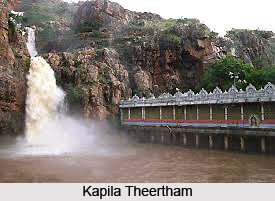 Kapila Theertham or the Holy Temple of Kapila Theertham is the ancient temple dedicated to Lord Shiva or Mahadeva. Kapila Theertham is the only temple dedicated to Lord Shiva or Mahadeva in over a 50 mile radius of the holy temple cities of Tirupati and Tirumala that abound with temples of the Vaishnavaite Deity, Lord Vishnu.
Kapila Theertham or the Holy Temple of Kapila Theertham is the ancient temple dedicated to Lord Shiva or Mahadeva. Kapila Theertham is the only temple dedicated to Lord Shiva or Mahadeva in over a 50 mile radius of the holy temple cities of Tirupati and Tirumala that abound with temples of the Vaishnavaite Deity, Lord Vishnu.
Kapila Theertham or the Holy Temple of Kapila Theertham is the huge temple, stands at the entrance to a mountain cave in one of the steep and vertical faces at the foot of the amazing hills of Tirumala, where the waters of the mountain stream Paapa Vinasanam fall as a huge waterfall.
A huge stone statue of a seated bull "Nandi", Lord`s Shiva`s steed, greets devotees and passers-by at the entrance to the temple. It is said that one of the holiest of Hindu saints, Saint Kapila, was said to have lived here, worshipped, and meditated in this very cave before the idol of Lord Shiva and hence the name "Kapila theertham", the word "theertham" means a holy lake or holy pond that formed due to the waterfalls.
Patronage.
Though this temple`s significance has diminished due to the hugely popular neighbouring Temples in Tirumala and Tiruchanoor, it received very good patronage from the Kings of Vijayanagara in the 13th thru 16th centuries, especially Saluva Narasimha Deva Raya, and the eternally famous Sri Krishna Deva Raya, and some of the later rulers like Venkatapathi Raya, and Aliya Ramaraya, Sro Krishna Deva Raya`s Son-in-law.
Under the able administration of the TTD, Kapila Theertham or the Holy Temple of Kapila Theertham receives continued protection and sustenance, annual festivals that are celebrated in pomp and celebration no lesser in significance than the popular Brahmotsavam of Tirumala on the hilltop.
During Kartika month on the occasion of its "mukkoti" on the `Purnima` (full moon) day, all the teerthas situated in the three world`s merge into this Kapila Teertham at noon for ten "Ghatikas"( one ghatika is equivalent to 24 minutes). It is believed that persons bathing in it at that auspicious time will attain salvation from the cycle of birth and death (`Brahmaloka`). Moreover those who have ever offered pindam ( tthidhi or thadhhina) to their father, mother or departed souls can do it here and wash off the sins for non performance of thadhhina or devasam ( in Tamil).





















